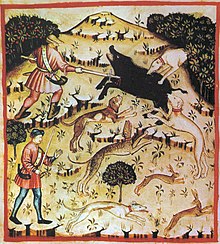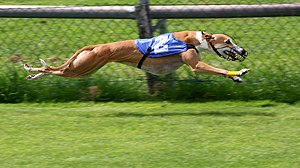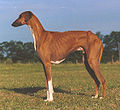Greyhound

Greyhounds (obsolete wind chimes ) is the name for all leggy and slender hounds that hunt their prey on sight. Their original task was to catch up with healthy game (rabbits, foxes, deer) while running. Greyhounds are one of the fastest land animals on earth after the cheetah .
In the FCI systematics , greyhounds belong to group 10 . Some greyhound-like breeds from the Podencos family are listed in Group 5 - Spitz and Primordial Dogs . According to the Anglo-Saxon system , the greyhounds are classified as part of the hound group .
Surname
The term greyhound , which is widespread in German , may originally mean wendic (Slavic) dog, which then indicated that greyhounds in the German-speaking area were mainly known from the Slavic area. Then the reference to the German word wind (draft) would be a classic case of folk etymology . According to another opinion, the older term “ wint ” is a translation or modification of the Latin “ contractus ” . “The latter term, which was used in the old Germanic popular rights , originates - as already postulated by Arrian - originally from the Celtic and refers to the speed of this type of dog. The explanatory composition of wind-dog or wind-game was only made at a later time. So it was not a folk etymology.
The possibility that wint referred to the hunt in Old High German would like to point out the context of the hunt .
In English , greyhounds are called sighthounds or gazehounds according to their hunting method, sight hunting . In various Romance languages they are after their main prey as " rabbit dog " means ( fr. Lévrier , ital. Levriero , span. Lebrel , port. Lebrel ).
Different greyhound breeds correspond in their name to the term "greyhound" in the language of the country of origin. Examples are Spanish galgo (hence the breed Galgo Español ), Hungarian agár ( Magyar Agár ), Polish chart ( Chart Polski ) or Russian borsaja ( Borzoi ).
history

Antiquity
Together with the Molossian , the greyhound is the oldest known example of a phenotypic specialization of the domestic dog with regard to a certain use. Even the earliest pictures of dogs show examples of the greyhound type: slender, high-legged dogs with a pointed muzzle. In different regions different greyhound-like breeds have developed through breeding, which are adapted to the respective environmental conditions.
The oldest images of greyhounds can be found in ancient Egyptian representations from the predynastic period (4th millennium BC). The slender, high-legged hunting dogs of the Egyptians are referred to as Tesem in cynology and are most similar in type to the modern podencos . Some authors postulate that these races go back to the spread of the Tesems by the Phoenicians ; there is no conclusive evidence for this hypothesis.
In ancient Greece , Xenophon wrote in the 4th century BC With his work Kynegetikós the oldest surviving description of the different types of hunting dogs. In it he describes in detail the technique of baiting rabbits with greyhounds.
In ancient Rome , Arrian wrote various treatises on hunting with dogs in the 2nd century AD. He shared the hounds into three different groups, namely Pugnaces ( Toy Group ), sagaces ( Bracken , hounds ) and Celeres (Greyhounds). Other names for greyhounds from ancient Rome are contracti and canes græci (Greek dogs; derived from the graioïde dog type ).
middle Ages

In the Middle Ages , the possession of greyhounds became a privilege of the nobility . King Canute the Great of England enacted his Forest Laws in 1016 , in which he stipulated that only nobles were allowed to own greyhounds. Unlike most other dogs, greyhounds enjoyed a high reputation; for example, King Howell the Good passed a law in Wales in the 10th century that punished killing a greyhound with the death penalty . The price charged for a greyhound was even higher than for a serf .
Edmund de Langley described the ideal greyhound in his book Mayster of Game in 1370 :
“The greyhound should have a long, somewhat pointed head, a good, large mouth with a scissor bite. [...] His neck should be strong and long, curved like a swan; the shoulders like a roebuck, the front legs straight, but not the hind legs [...] the paws round like a cat, with large claws; the bones and joints on the thigh large and strong like a deer; the lower legs strong and arched like a hare; the hoes straight, and not twisted like an ox. The tail like that of the cat, with a ring at the end, but not too high. "
The legend of the Guinefort greyhound , who was venerated as a saint in the French region of Dombes from the 13th century, also dates back to the Middle Ages .
Renaissance
In the Renaissance , the possession of greyhounds remained a privilege of the nobility. In the 16th century, the Duke of Norfolk , commissioned by Queen Elizabeth I , wrote rules for the hare-baiting with greyhounds for the first time, in which, among other things, the number of dogs per hare, the lead to be granted to the hare and the provisions for scoring a run were recorded.
use
hunt
Greyhounds were bred to hunt by sight - they do not pursue their prey with the help of their sense of smell , but with the help of sight . Outside Europe, but also in some European countries such as Spain , Russia and Ireland , greyhounds are still widely used for hunting. The most common of these is rabbit baiting .
In addition to rabbit baiting, sight hunting with sighthounds has also historically been used as a method to hunt larger animals - for example deer ( Deerhound , Staghound ) and wolves ( Borzoi , Irish Wolfhound ). Greyhounds are still used to hunt coyotes in the American West today. On the Arabian Peninsula , saluki are used together with falcons to hunt hares and gazelles.
Dog sport
Although all greyhound breeds were originally bred for hunting, in most European countries they are now only kept as house and companion dogs and used for amateur sporting events such as dog races and coursings. In the Anglo-Saxon countries commercial greyhound races are common, in which greyhounds and whippets are used almost exclusively .
Systematics
According to origin
Within the greyhounds, the following groups are further distinguished according to their geographical origin:
- Occidental Greyhounds ( Rose Ears , Sprinters)
- Oriental greyhounds (floppy ears, more independent by nature, more persistent)
- Mediterranean greyhounds (recognizable by their erect ears, as shown by the Pharaoh Hound )
Whippet , Little English Greyhound (Occidental Type)
Azawakh ,
Tuareg greyhound (oriental type)Podenco Ibicenco (Mediterranean type)
Occidental Greyhounds include Borzoi (Russian Greyhound), Chart Polski (Polish Greyhound), Deerhound (Scottish Greyhound), Galgo Español (Spanish / Iberian Greyhound), Greyhound (Great English Greyhound), Irish Wolfhound (Irish Greyhound), Italian Greyhound ( Italian greyhound), Magyar Agár (Hungarian greyhound) and Whippet (small English greyhound).
Oriental greyhounds include Afghan Hound (Afghan) , Azawakh (Tuareg greyhound), Saluki (Persian greyhound), and Sloughi (North African greyhound).
Mediterranean greyhounds include Cirneco dell'Etna , Pharaoh Hound , Podenco Canario , Podenco Ibicenco and Podengo Português .
According to hunting behavior
Greyhounds can also be subdivided based on their hunting behavior into breeds that are supposed to catch up with and kill their prey ( kill , for example Greyhound, Whippet, Silken Windsprite, Irish Wolfhound), and breeds that are supposed to catch up with their prey and hold it at bay until the hunter arrives and kills the prey (for example Azawakh, Deerhound).
FCI greyhound breeds
The FCI currently recognizes 13 breeds in group 10 and five breeds in group 5, which differ greatly in terms of coat, size and appearance. The following greyhound breeds are currently recognized in FCI Group 10 :
Section 1: Long-haired or feathered greyhounds
Section 2: Wire-haired Greyhounds
Section 3: Shorthaired Greyhounds
- Azawakh
- Chart Polski
- Galgo Español
- Greyhound
- Italian greyhound
- Magyar Agar (Hungarian Greyhound)
- Sloughi
- Whippet
Greyhound-like breeds
In the FCI group 5 are the following wind dog-like breeds that are sometimes referred to as "Mediterranean Greyhounds":
Greyhound breeds not recognized by the FCI
- American staghound
- Khortai
- Criticism Lagonikos ( recognized nationally for Germany by the VDH ; hereinafter referred to as: VDH recognized)
- Longhaired Whippet / Silken Windsprite (VDH recognized)
- Central Asian tazi
- Mudhol Hound
- Podenco Andaluz (VDH recognized)
- Silken Windhound
- Taigan (VDH recognized)
Hybrid dogs with greyhound share
Individual evidence
- ↑ Georg Ludwig Hartig: Textbook for hunters and who want to be . tape 2 . Cotta, Tübingen 1812, p. 125 .
- ^ Greyhound in Duden , accessed on April 2, 2012
- ↑ Kurt Lindner in The Hunt in the Early Middle Ages , Walter de Gruyter, 1940, p. 275 (limited preview on Google Books)
- ^ English translation of the Kynegetikós , accessed on February 24, 2012
- ^ Cynegeticus des Arrian on Google Books, accessed February 24, 2012
- ↑ Ancient Greek and Ancient Roman depictions of greyhounds ( memento of April 23, 2012 in the Internet Archive ), accessed on February 24, 2012
- ^ Dogs in Ancient Greece and Rome , University of Chicago, accessed February 24, 2012
- ^ R. Short: King Canute and the Wisdom of Forest Conservation . Nature 2009, 462, p. 567
- ^ History of Greyhounds: Medieval and Renaissance , accessed February 24, 2012
- ^ Quotes from Greyhound Literature , accessed February 27, 2012
- ↑ Rules of Renaissance Coursing , accessed February 27, 2012
- ^ Hunting in Tudor England , Tudorplace.com.ar, accessed February 27, 2012
- ↑ Eric Eliason: Great Plains Coyote Coursing: Biofacts and a new Folkloristic Understanding of Animals . In: Wild games: hunting and fishing traditions in North America , University of Tennessee Press, 2009, ISBN 1-57233-670-6 , pp. 25-45
- ^ GR Smith: Observations on hunting in the Arabian Peninsula In: Asian Affairs 1979 9 (2), pp. 186-190, doi : 10.1080 / 03068377808729895





